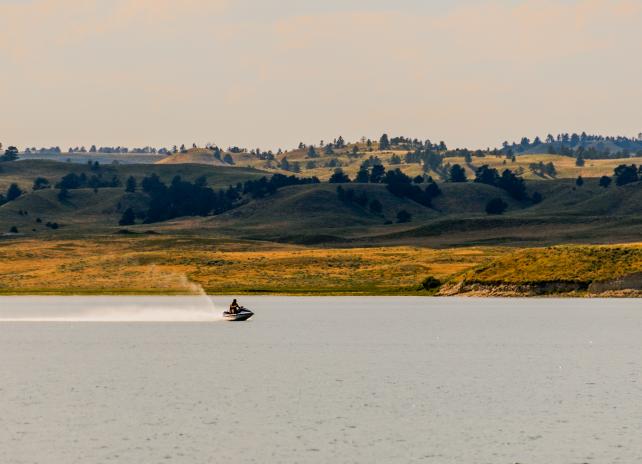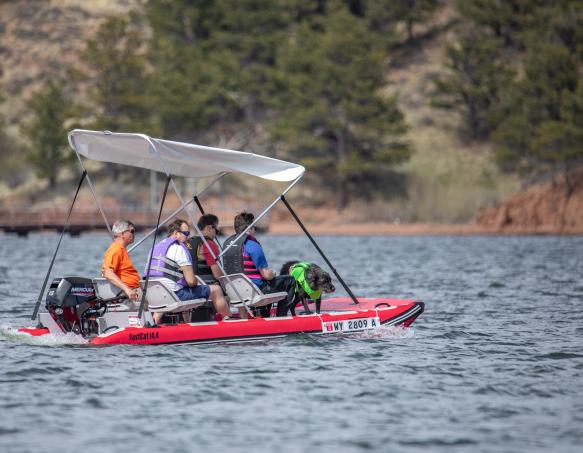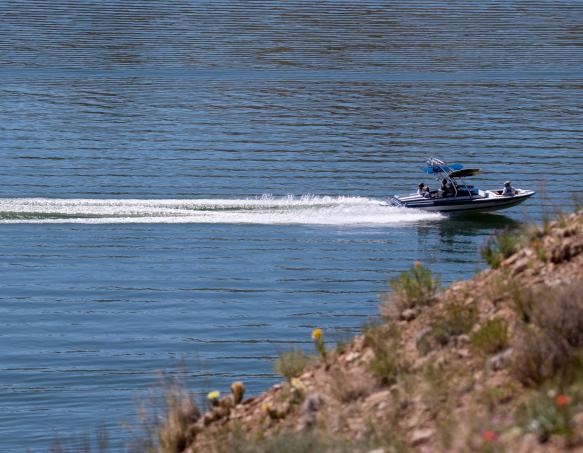
Boating - Watercraft
Get ready for your next adventure on one of Wyoming's breathtaking lakes, rivers or reservoirs. Discover a wealth of information about operating boats and other watercraft in Wyoming. Access essential resources, including regulations, safety and watercraft registration information. This page offers details from watercraft registration requirements to an interactive map of Wyoming's waters to ensure a smooth boating experience. Dive in and explore the wonders of boating in the Cowboy State!
Watercraft registration information


Accident report
The operator of any watercraft involved in an accident on any of the waters of Wyoming must notify a Wyoming law enforcement agency of the accident immediately.
Required safety equipment
You are required by law to carry the necessary safety equipment aboard your watercraft. Safety equipment requirements vary by the class of your boat, which is determined by the boat's length. This reference will help identify the safety equipment you will need on board.
Additional safety information is available in the courses listed below.
| Class A | Less than 16 feet |
| Class B | 16 to <26 feet |
| Class C | 26 to <40 feet |
| Class D | 40 feet and up |
Flotation devices
- All boats must carry a properly-sized, U.S. Coast Guard-approved wearable life jacket for each person on board.
- Class B, C and D boats also must carry at least one (1) U.S. Coast Guard-approved throwable flotation device (ring buoy or float cushion).
- Life jackets must be worn at all times when riding a personal watercraft or when being towed by or riding in the wake of a watercraft. Kids 12 years of age and under must wear a life jacket while the watercraft is underway.
Lights
- From sunset to sunrise, all motorized watercraft and sailboats must display a red and green combined lantern in the front of the boat, and a white light aft visible 360 degrees when underway.
- All watercraft at anchor or adrift between sunset and sunrise must display a white light to show all around the horizon and be visible for two miles.
- Hand-powered watercraft must have lighting ready at hand to avoid collision.
- No other lights that may be mistaken for navigation lights shall be used from sunset to sunrise.
- Different classes require different lighting. Refer to the watercraft regulations for more information.
Fire extinguishers
All boats with inboard engines, compartments where fuel tanks or combustible material may be stored,double bottoms not sealed to hull, closed living spaces or permanently installed fuel tanks must have the proper fire extinguisher(s).
Sound-producing devices
All motorized watercraft shall have an efficient sound-producing device on board.
Common boating violations
The following are common boating violations encountered by game wardens while patrolling the state's lakes and rivers. Refer to the Wyoming Watercraft Regulation for more information.
Failing to carry proper safety equipment
- Life jackets of the proper size for everyone on board.
- Throwable flotation device on boats 16 feet or longer.
- Fire extinguisher on motorized boats with enclosed compartments.
- Sound-producing device.
Improper registration
- Operating an unregistered boat.
- Failing to carry a certificate of number on board.
- Improper display of numbers.
Unsafe operation
- Failing to obey buoys or markers.
- Operation by a person under 16 years of age.
- Careless or reckless operation of watercraft.
- Boating under the influence (BUI).
Hull Identification Number (HIN) and inspection form
What is a HIN?
- All boats manufactured or imported on or after Nov. 1, 1972 bear a HIN. The HIN is a 12 alpha-numeric character that uniquely identifies a boat.
- The HIN is a federal requirement; a boat's registration number is a state requirement, similar to the license plate on a car. The HIN, however, must be shown on the state registration certificate.
- It is illegal for anyone (manufacturer, dealer, distributor or owner) to alter or remove a HIN without the express written authorization of the Commandant, U.S. Coast Guard.
- The regulations prescribe the format of the HIN. The first three characters are a MIC (Manufacturer Identification Code) assigned by the Coast Guard to the manufacturer or the person importing the boat; characters four through eight are a serial number assigned by the manufacturer; the last four characters indicate the month and year the boat was built, and the model year. Prior to Aug. 1, 1984, the manufacturer had the option of expressing this in the form of a model year designation.
- Individuals building boats for their own use, or boat owners registering a boat that does not have a manufacturer HIN must obtain a 12-character HIN from their state boating agency.
Hull Identification Number FAQs
-
Answer
- The owner of the watercraft shall apply to the Wyoming Game and Fish Department on a form furnished by the Department for the application/registration of State issued HINs.
- The form shall contain a complete description of the watercraft, name and address of the owner, and any other information as required by the Department.
-
Answer
- Under authority granted by the United State Coast Guard, the Department shall assign HINs beginning with the letters WYZ followed by consecutively assigned numbers.
- The Department shall not register any watercraft with an invalid/nonconforming HIN except for renewals.
-
Answer
- The primary HIN must be permanently affixed (so that it can be seen from outside the boat) to the starboard side of the transom within two inches of the top of the transom, gunwale, or hull/deck joint, whichever is lowest. On boats without transoms or on boats on which it would be impractical to apply to the transom, the HIN must be affixed to the starboard outboard side of the hull, aft within one foot of the stern and within two inches of the top of hull side, gunwale, or hull/deck joint, whichever is lowest. The starboard outboard side of the hull aft is the preferred HIN location for many manufacturers. On catamarans and pontoon boats the HIN must be affixed on the aft crossbeam within one foot of the starboard hull attachment.
- The character size of each HIN must be no less than one-fourth of an inch high. A duplicate secondary HIN shall be affixed somewhere on an unexposed location inside the boat or beneath a fitting or item of hardware. The purpose is to help authorities identify a boat if a thief or vandals remove or damage the primary HIN on the transom.
